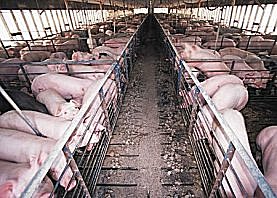|
|||||||||||||||||||||||||||
November 01, 2007
 The economics of Neolithic ham
The economics of Neolithic ham
Many Spanish households keep a whole cured ham, taken out when they
need a few slices for a tapa or a sandwich. We have joined them, and a
shoulder (paleta) of Jabugo ham sits on a worktop in the
utility room, its black cloven hoof sticking out of the tea-towel that
is all we need to protect it for several months.
Spain is the country that takes air-cured ham seriously, as Belgium does beer. Hams hang from the ceiling in many pubs. Spaniards will pay a lot for the best quality: from the small, hardy, black-hoofed Iberian pig (ibérico), reared on acorns (bellota) in the sierras and savannahs of Andalucia, Salamanca and Extremadura. Less expensive hams (ibérico cebo or recebo) come from the same races of pig but reared in free-range piggeries, with some acorns in the feed; the standard grade (plain serrano) from faster-growing pigs reared intensively on who knows what.
These grades correspond to the main phases in the history of animal husbandry. The cheapest grade comes from modern factory farming, as much a twentieth-century invention as poison gas. The nature of the product means I think that it can't be pushed nearly as far for any serrano ham as for Danish bacon.

The previous system was of smaller piggeries, typically combining outdoor pens and indoor styes. That was how Dr. Johnson's London was supplied with pork chops. I can't find out when this became the dominant method in Europe; I suppose the late mediaeval or Renaissance periods, much earlier in China. The original neolithic system however involved a swineherd driving herds of pigs into forests for part of the year to find acorns, beechmast and mushrooms. Spanish bellota ham is a rare survivor of neolithic livestock technology.

The match is not perfect. Neolithic pigs would have spent the winter rooting in the squalid village midden, in search of food scraps, human waste, corpses of unvalued slaves, etcetera: possibly the habits that led to the Mosaic ban. Spanish bellota pigs are I hope fed grain over the winter in normal piggeries.
Spanish bellota pigs are a very lucky minority, but still number around 40,000, so this is not a niche product. The technologies of the three styles all enjoy roughly constant returns to scale; there are plenty of pigless oak forests around Madrid, and the price varies with producer rather than terroir; there are few barriers to entry. The price structure thus probably reflects costs rather than rents. These are prices for complete hams on the bone. Shoulders, smaller, bonier and tricker to carve, are half the price:
- Supermarket jamón serrano, cured 12 months : €10 /kg
- jamón ibérico recebo, age at slaughter 24 months, cured 24 months: €20 /kg
- jamón ibérico bellota, idem, €40-60 /kg.
Is it worth it? The taste is definitely superior. You don't need much to satisfy; an ounce or two is plenty. It is claimed that the acorns transform the fat into an unsaturated, healthier form. And you are striking a blow with your stone axe for animal welfare.
Photo credits: wikimedia and this tourism site.
 |
|
Thread: Agiculture , Thread: Economics , Thread: Europe , Thread: Woolgathering


